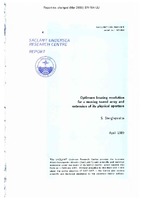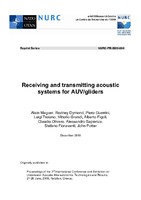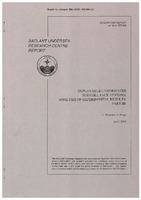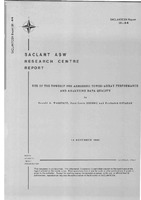| dc.contributor.author | Stergiopoulos, S. | |
| dc.date.accessioned | 2018-10-11T14:06:46Z | |
| dc.date.available | 2018-10-11T14:06:46Z | |
| dc.date.issued | 1989/04 | |
| dc.identifier | 1934 | |
| dc.identifier.govdoc | SR-154 | |
| dc.identifier.uri | http://hdl.handle.net/20.500.12489/296 | |
| dc.description.abstract | This report examines the limits of the angular resolution capability of a moving towed array (MTA) by | |
| dc.description.abstract | finding the Cramer-Rao lower bound (CRLB), provides algorithms that extend the physical aperture of | |
| dc.description.abstract | an MTA and compares the performance of these algorithms with the limits provided by the CRLBs. The model which is considered for the CRLB estimates assumes that an N hydrophone towed array is moving with known constant speed and that in the received signal unknowns are all the parameters (i.e. amplitude, frequency, bearing, initial phase) for two sources. The estimated CRLBs for this model | |
| dc.description.abstract | indicated that an N-hydrophone MTA provides very high angular resolution when the duration T os the | |
| dc.description.abstract | received signal is very long. This ability of the moving array to resolve two closely spaced sources is | |
| dc.description.abstract | related to the fact that the physical aperture has been extended by the distance travelled by the array during the T seconds of the observation period. In the case of one source, the MTA has improved | |
| dc.description.abstract | performance in comparison with a stationary array under the assumption that the transmitted | |
| dc.description.abstract | frequency of the source is known. Computer simulation examples using a maximum likelihood estimator and an extended towed-array algorithm to find the bearings of sources are presented. The | |
| dc.description.abstract | results of these simulations agree with the CRLB if the signal-to-noise ration is higher than 0 dB at the | |
| dc.description.abstract | hydrophone level. Below this value the performance of both methods rapidly deteriorates. Applications of the extended towed-array algorithm on real data were successful, and the physical | |
| dc.description.abstract | aperture of a 32-hydrophone MTA was extended to an equivalent of a 512-hydrophone fully populated | |
| dc.description.abstract | stationary array. | |
| dc.format | vi, 43 p. : ill. ; 21 fig. | |
| dc.language | English | |
| dc.publisher | NATO. SACLANTCEN | |
| dc.relation.ispartofseries | ADB136086 | |
| dc.subject | Analog towed arrays | |
| dc.subject | Digital towed arrays | |
| dc.subject | Hydrophones | |
| dc.subject | Passive arrays | |
| dc.subject | Sonar arrays | |
| dc.subject | Signal processing | |
| dc.subject | Algorithms | |
| dc.title | Optimum bearing resolution for a moving towed array and extension of its physical aperture | |
| dc.type | Scientific Report (SR) | |



